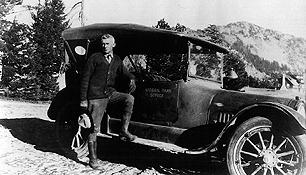***previous*** — ***next***
Crater Lake National Park News
Who remembers Judge Sparrow?
Sparrow’s road around the rim of Crater Lake opened Oregon’s only national park to automobile tourists. Mail Tribune Medford, Oregon July 1, 1999 By Jonel Aleccia

Alex Sparrow, superintendent of Crater Lake National Park in this 1922 photograph, became one of the most popular figures in Jackson County before he died in 1932. (SOHS No. 15730)
A career Army man who helped shape Jackson County and Crater Lake National Park died suddenly in 1932
The funeral procession stretched five miles — from Central Point to Jacksonville — on Jan. 29, 1932, as thousands of stunned Rogue Valley residents mourned the sudden demise of a popular political leader.
Alex Sparrow was dead.
Nearly seven decades later, few residents can recall the handsome, charismatic engineer and county judge who forged the rim road around Crater Lake and spearheaded construction of the Jackson County Courthouse.
But from his 1913 arrival in Jackson County to his untimely death after tripping backwards into a Klamath Falls coal bin, Sparrow was a powerful, respected force in area politics.
“Here was a guy who was likable, but who had a high level of integrity,” says Bill Alley, historian and archivist for the Southern Oregon Historical Society. “He was at home with the upper crust, but he could curse with the best of them.”
Photos of Sparrow at Crater Lake reveal a tall, dapper man with handsome features and a commanding air. Surely some of that confidence was acquired during his 24-year career in the U.S. Army. Born in Toronto, Ontario, in 1871, Sparrow lied about his age to enlist and spent six years in the U.S. Cavalry before joining the Corps of Engineers.
He fought in the Spanish-American War, and served tours of duty in the Philippines and Cuba, before retiring in 1912.
Sparrow was 42 when he was tapped by the Department of the Interior to oversee construction of the Crater Lake road system.
In 1917, Sparrow was named superintendent of the park, which that year attracted some 12,000 visitors. He made the first trip around the newly completed rim road in September 1918, hazarding tight turns and deep ruts in a Park Service truck.
A year later, the visitor count rose by more than 4,000, mostly on the strength of Sparrow’s roads.
“I congratulate you heartily on the effective work that you have done since you were placed in charge of the park,” acting director of the National Park Service Horace Albright wrote in an October 1917 letter.
The superintendent was popular with area business leaders and residents as well. With winter offices in Medford, he was a leading member of the Elks Lodge and a frequent guest at area social events.
His stature — and stability — increased in 1921, when Sparrow, then 50, began squiring Ruth Clemens, a 30-year-old mother of two. She had come to Crater Lake to recover from what family members called “an unfortunate previous marriage.”
Upon the death of her first husband, the young widow and Sparrow were married in a quiet church ceremony on May 9, 1922.
Soon after the marriage, Sparrow resigned as park superintendent, retiring this time to enjoy his new family. They settled on Kirtland Farm in Central Point.
Five years later, his reverie was interrupted by the death of County Judge W.J. Hartzell, who held the post analogous to today’s county commissioners. Local Republicans tapped Sparrow to serve Hartzell’s remaining term for the post and stand for reelection in 1928.
He was so popular that no Republicans and, indeed, no Democrats challenged him. He ran unopposed, winning the 6-year term.
As judge, Sparrow used his engineering training to the county’s advantage. He was especially involved in construction of the Jackson County Courthouse at the corner of Main Street and South Oakdale Avenue, envisioned as “one of the most dignified and impressive buildings in the state.”
But Sparrow never saw his vision completed. On Jan. 20, 1932, the judge was inspecting a prospective heating unit for the new courthouse. While someone searched for a light switch in the basement of the Hirvi Building in Klamath Falls, Sparrow stepped backward in the dark, plunging into a coal bin and striking his skull. Four days later, he died of his injuries. He was 61.
Sparrow’s road around the rim of Crater Lake opened Oregon’s only national park to automobile tourists.
The mourning county memorialized Sparrow by designating the new public health wing of the courthouse the Alex Sparrow Memorial Clinic. It was to be “a definite and lasting monument to his service.” The courthouse was dedicated on Sept. 1, 1932.
But the Sparrow wing, along with other monuments, vanished over the years as new administrations and new needs transformed the public building.
“None of the memorials have lasted,” notes Alley. “What do they say? ‘Gone, but not forgotten?’ Well, that’s not true.”
Still, Sparrow’s legacy lingers, residing in the curves of the Crater Lake rim road, in the marble halls of the courthouse and in the history of people who lined up for miles on a January day just to bid him good-bye.
***previous*** — ***next***
***menu***

